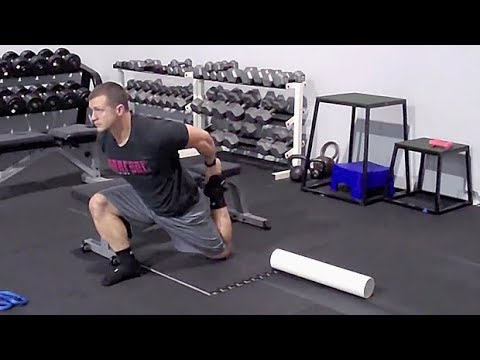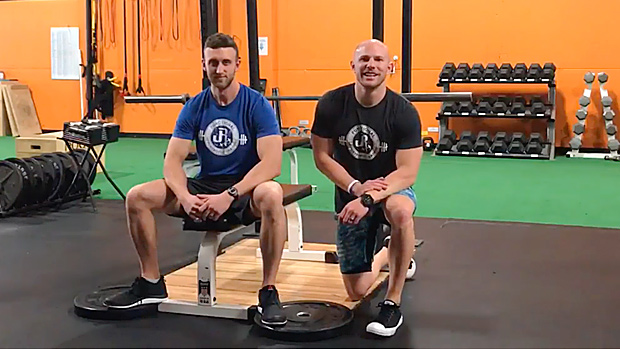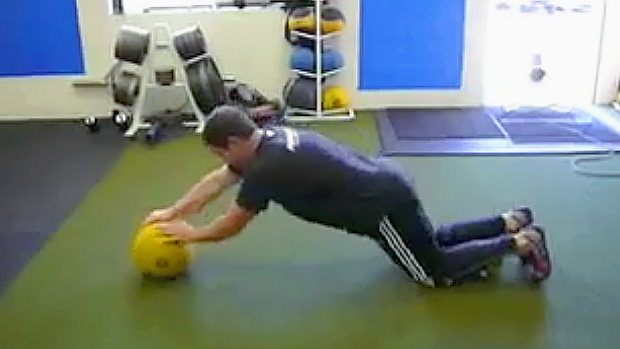Here's what you need to know...
- If you're training hard without improvements in strength, muscle mass, or leanness, you've become nonresponsive or desensitized to your workouts.
- You can prevent desensitization by using deloads. There are three kinds: intensity, volume, and frequency deloads.
- To correct a nonresponsive body, specialize on a body part or lift, switch to another kind of exercise altogether, or take time off.
Training Hard, Getting No Results
You train harder than most people. Sick, hurt, strapped for time, doesn't matter, you find a way. You're doing everything right, but you aren't progressing.
You aren't putting on more muscle. You aren't getting stronger or leaner. And you're frustrated.
So what's your problem?
You're A Non-Responder
You've become desensitized – immune – to training. This happens to stimulus addicts: those who train more often, longer, and harder than everybody else.
Training stimulus addicts are emotionally driven and their instinctive reaction to a lack of progress is to do more, go harder, train longer. This is the drawback of being passionate about training – you become your own worst enemy.
Perturbation and Adaptation
Gaining size and strength is how the body protects itself. Physical work stresses the body, the body experiences it as a perturbation or disturbance, then adapts in order to handle it.
But once adapted, the same volume and intensity won't perturb your body anymore. At some point you get used to the workload and you must maintain it just to maintain muscle and strength. You either stagnate or increase the workload.
And it's not a matter of recovery. Don't think you can just continue adding more work and trying recover from it. Even if you do recover from more stimulation, it's a short-term solution until your body becomes adapted to the new workload.
The bad news: If you don't change the way you do things, you'll continue working hard without progress.
The good news: If you're willing to change your ways and do things that'll be emotionally hard for you to handle you'll quickly begin progressing again.
Is it more important for you to feel good about working hard or getting maximum results?

How to Make Your Body Respond Again
There are several effective strategies that'll beat desensitization. Preventive strategies keep the body responsive to stimulation, but they don't cure training desensitization.
If you're already exhibiting signs of it – no progress, feeling stuck in a rut, not getting good pumps – other strategies can help correct it.
Prevention Tools
Deloading means decreasing the magnitude of the training stress for a brief period of time (5 to 10 days). The three most commonly used are intensity, volume, and frequency.
1 – Intensity Deload
"Intensity" in training is the level of effort relative to your maximal effort. No matter what kind of lifter you are, an intensity deload means not pushing your sets as hard as usual. The volume of work and frequency of training remains similar though.
Powerlifting and strength: Use a percentage of your 1RM to define intensity in training. Since intensity is planned via percentages it's easy to simply play with those percentages for a deload.
For you, intensity deloading means decreasing the amount of weight used for your sets (without adding more volume).
Use 10-15% less than you did the week prior. If you did 5 x 5 @ 80%, then do 5 x 5 @ 65-70%. Lowering more than that isn't necessary or effective.
Bodybuilding and hypertrophy: If you don't lift using planned percentages, then "intensity" is the maximum fatigue you can tolerate in a set.
Stopping a set short of failure is a lower intensity than using maximum pump methods, extended sets, drop sets, forced reps, and negatives. Even if you're using more weight, stopping a set short of failure is still lower intensity.
If you're doing bodybuilding work it's more subjective. If you were going to failure or beyond, stop 1-2 reps short. If you were stopping 1-2 reps short, stop even before that.
Notes: Intensity deloads are best used by those doing bodybuilding workouts. Do a deload every 4th week.
2 – Volume Deload
If you're training for strength, a volume deload is the best choice. Decrease training volume by 40-50% but keep the same level of intensity/effort. You can either reduce the number of reps per set, sets per exercise, or number of exercises.
Let's say that your normal (non-deload) workout looks like this:
- A. Bench press: 5 x 5 @ 275 lbs
- B. Close-grip bench press: 4 x 8 @ 205 lbs
- C. Incline Dumbbell press: 4 x 8 @ 140 lbs (70 lbs per hand)
- D. Dumbbell lying triceps extension: 4 x 12 @ 60 lbs (30 lbs per hand)
You can deload in volume by reducing reps:
- Instead of 5 x 5, do 5 x 3.
- Instead of 4 x 8, do 4 x 5.
- Instead of 4 x 12, do 4 x 6.
The weight on all exercises would remain the same.
Or by decreasing sets:
Keeping the exercises and weights the same, you'd simply do 2-3 fewer sets per movement.
Or by dropping exercises:
The sets and reps remain the same, but you use only two exercises:
- A. Bench press: 5 x 5 @ 275 lbs
- B. Close-grip bench press: 4 x 8 @ 205 lbs
In all three cases you reduce volume by 40-50% and avoid getting used to a certain workload.
Notes: Strength athletes need to keep in touch with heavy weights even when deloading to keep the nervous system sharp. You resensitize your body by decreasing the amount of work you're doing. Deload every 4th week.
3 – Frequency Deload
If you use high frequency training – training a lift or body part three times a week or more – then decrease the number of times you hit certain lifts or muscle groups. Cut them in half every 4-5 weeks.
Yes, high frequency training works. But what makes you efficient quickly can also make you desensitized quickly. It'll become increasingly more difficult to create perturbation.
For a frequency deload, drop frequency by 50% or more for two weeks.
- If you train a specific lift 6 days a week, train it 3 days per week.
- If you train a specific lift 4 or 5 days a week, train it 2 days a week.
- If you train a specific lift 3 days a week, train it once a week.
Don't drop volume as much as you would for a volume deload. It can be 75-80% of your normal volume for a week. The goal is to prevent desensitization to training frequency, not to supercompensate via a drop in volume.
Frequency Deload: Option 2
If you consistently train 5-7 days a week it's possible to get accustomed to weekly physical stress. Even if you switch exercises and targeted muscles every day, you can still become desensitized.
Reducing overall frequency after 8 or 12 weeks of intense training is a good solution to prevent desensitization. Cut training frequency in half. So for two weeks train only 2-3 times per week.
Opposite Training
This is the most common approach to prevent training desensitization. It simply refers to changing the training program you're on. And when it comes to preventing desensitization, the greater the change, the better. You can change:
- Overall training frequency (days of training per week)
- Frequency per muscle or lift during the week
- Number and type of exercises
- Sets per muscle group
- Average reps per set or loading scheme
- Way of doing reps (explosive, constant tension, slow eccentric, etc.)
- Intensification methods (supersets, drop sets, rest-pause, etc.)
If you stay fairly similar in most categories – for example keeping a similar training split, sets and reps per exercise, rep type – and only change the exercises, you won't change the nature of the stress much.
So when using this approach, switch to a training program that's different in many regards to your previous program. I call this opposite training.
Doing mostly higher reps? Switch to lower reps with heavier weight. Doing 3 sets of 5 exercises per muscle group? Try 6 sets of 2 exercises per muscle group. Doing constant tension "slow and squeeze" reps? Lift explosively.
It's not important to use a training approach that's 100% specific for your goal because you're using this change to keep your body responsive to your main training plan.
Notes: You don't want to change exercises so often that you never master the basics.
But when you use this prevention technique, you have to train in a way that's the total opposite of how your normally train. The further you get from your regular training, the more effective it will be.
It might not be the best way to train to get closer to your goal, but it's better than not training at all to resensitize your body, and you might start gaining again just because of the novel stimulus.

How to Correct Desensitization
1 – Specialization Training
The more advanced you are, the greater the training stress needs to be to stimulate further changes. As you grow more advanced, your body becomes better adapted to physical stress.
The beauty of this spec system is that it allows you to resensitize certain muscles while you accelerate growth in others. If you drastically reduce training volume for the parts you're not specializing on, you'll make these muscles responsive again in the future.
Pick one or two muscle groups (or one strength lift) to focus on for the duration of the 4-week training block. Train these 3 days a week.
If you pick two muscle groups, you train both muscles on the same days. The rest of the body is trained at maintenance level, and is divided among two other training days.
Maintenance training is the key. Training stimulus addicts have a hard time decreasing the amount of work for the rest of the body, but it's essential for the success of this approach.
You have only so much training currency to invest every week. If you decide to invest more on certain muscle groups, you'll need to decrease the amount you invest elsewhere.
Notes: Training specialization gives your training a new life. Focusing hard on one thing makes you attack a weakness with all you've got.
And while you're resensitizing the rest of your body, you still get the feeling of training as hard as you can.
The biggest drawback of this approach is that the vast majority of people do too much work for the non-specialized body parts or lifts. The goal is to resensitize them. You should do a minimal amount of work – as little as 2-3 work sets – for those muscles. You could even not train them at all and it would work.
When it comes to resensitizing the body, the less work you do, the better it'll work.
2 – Drastic Blitz Training
Take "switching up your training" to another level. Do something completely different that belongs in another fitness realm completely. Stop lifting for two weeks and only do sprints, jumps, throws, and body weight exercises. Or simply play sports.
Use this extreme approach when you haven't progressed at all in months. When nothing works, you need to take a step back. Doing something completely different will allow you to resensitize your body and make gains once you come back.
Don't worry, you won't lose any muscle mass in two weeks, especially if you stay relatively active. And you'll develop other physical qualities during that period.
Now, you might feel smaller, but that'll be because your muscles will be less inflamed and will store a bit less glycogen. And even if you were to lose 1-2 pounds of muscle, if that allows you to gain 7-10 pounds more after months of no progression, it's not a bad deal.
There's also a psychological benefit. When you hit a wall and fail to progress, training occupies your mind 24/7. It's frustrating.
Doing something else will renew your passion and motivation for lifting which will enhance the quality of your workouts when you come back.
Notes: Only use this extreme approach when you've tried both opposite training and specialization training and still find yourself not improving. It's not the first option for a system reboot.
Not lifting is emotionally difficult, especially if you're addicted to the iron. But ask yourself, is it better to stay away from the gym for two weeks or to stop progressing completely?
3 – Planned Detraining
This is also called strategic deconditioning. At the end of every 6-8 week training cycle, take 9-12 days off.
That time without training is not to recover or supercompensate. It will of course happen, but that's not the goal. Sure, after 6-8 weeks of training, you might think, "I still feel fresh so taking a break would be useless!" But the goal of the time off is to keep the body sensitive and responsive.
The duration of the detraining period is important. For up to 7 days you won't lose any adaptation at all. So taking 5-7 days of rest wouldn't work to keep the body sensitive to training, at least not optimally. And more than two weeks will make you lose some gains.
So 9-12 days of rest is the best length to keep your body responsive to training without losing gains.
For strength athletes, a benefit of a period without training is a conversion of IIa muscle fibers into IIb fibers. These are both fast-twitch fibers and they have a high level of force production. Your IIb fibers have a rate of contraction up to twice as fast as the IIa.
Any form of training, even heavy lifting and explosive work, will initiate a conversion of the IIb fibers into IIa fibers. Why? Because the IIb are essentially "reserve" fibers.
Now, during a period of detraining, IIa fibers will initiate a change toward a IIb profile. Which will increase your potential for power and strength.
When athletes take 2-3 weeks off, their strength is as high as it was or higher, but their work capacity decreases. They'll be really strong for 1 or 2 high intensity work sets, and then strength drops dramatically after that, whereas before the break they could handle 5 or even 6 hard sets.
Including a period of detraining at the end of a very hard training cycle can keep your body responsive to training and performing at a high level.
4 – Extreme Detraining
Not only will you stop lifting for almost two weeks, but you won't engage in any form of physical training. This is an extreme solution for cases of serious desensitization.
For most, not lifting for about two weeks and staying physically active (sprinting, jumping, throwing, playing sports) will be fine. But if you feel like your situation is more serious, any form of intense physical activity may prevent you from getting resensitized to training.
This is tough to do but worth it. Being off for two weeks to make progress for the rest of the year is an investment.
Note: There's another level to this: extended time off. We're talking one to three months. Gains will be lost, but you'll work your way back up and then, newly resensitized, start progressing again. Better than being stuck for a year, but tough to do.
Now, if you reach a point where you need to take one to three months off it's because you made some pretty bad choices training-wise. Few people will ever need to use this strategy.
Unless you're a professional or an athlete training 20-30 hours a week you probably won't get into a situation that requires taking extended time off.
Make smart training choices to keep your body responsive.





